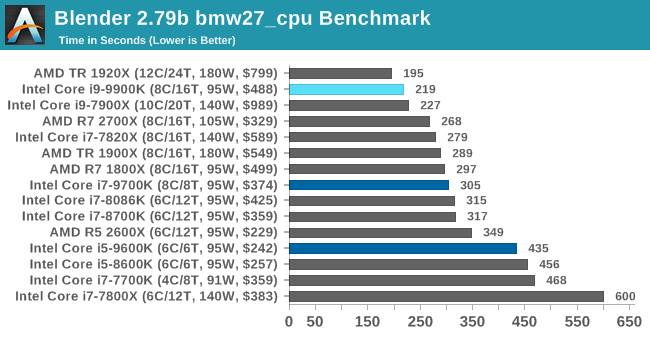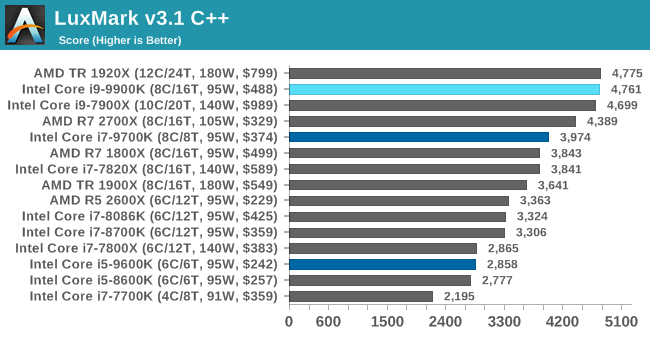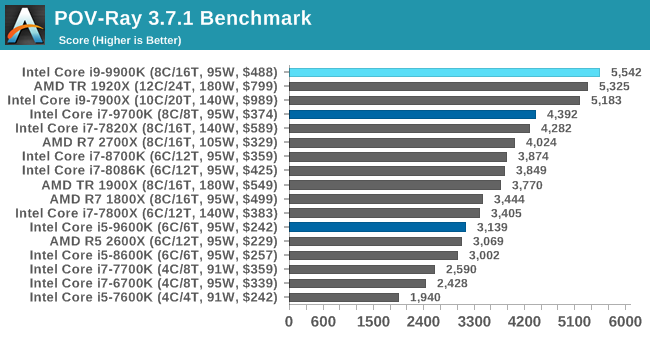The Intel 9th Gen Review: Core i9-9900K, Core i7-9700K and Core i5-9600K Tested
by Ian Cutress on October 19, 2018 9:00 AM EST- Posted in
- CPUs
- Intel
- Coffee Lake
- 14++
- Core 9th Gen
- Core-S
- i9-9900K
- i7-9700K
- i5-9600K
CPU Performance: Rendering Tests
Rendering is often a key target for processor workloads, lending itself to a professional environment. It comes in different formats as well, from 3D rendering through rasterization, such as games, or by ray tracing, and invokes the ability of the software to manage meshes, textures, collisions, aliasing, physics (in animations), and discarding unnecessary work. Most renderers offer CPU code paths, while a few use GPUs and select environments use FPGAs or dedicated ASICs. For big studios however, CPUs are still the hardware of choice.
All of our benchmark results can also be found in our benchmark engine, Bench.
Corona 1.3: Performance Render
An advanced performance based renderer for software such as 3ds Max and Cinema 4D, the Corona benchmark renders a generated scene as a standard under its 1.3 software version. Normally the GUI implementation of the benchmark shows the scene being built, and allows the user to upload the result as a ‘time to complete’.
We got in contact with the developer who gave us a command line version of the benchmark that does a direct output of results. Rather than reporting time, we report the average number of rays per second across six runs, as the performance scaling of a result per unit time is typically visually easier to understand.
The Corona benchmark website can be found at https://corona-renderer.com/benchmark

Corona is a fully multithreaded test, so the non-HT parts get a little behind here. The Core i9-9900K blasts through the AMD 8-core parts with a 25% margin, and taps on the door of the 12-core Threadripper.
Blender 2.79b: 3D Creation Suite
A high profile rendering tool, Blender is open-source allowing for massive amounts of configurability, and is used by a number of high-profile animation studios worldwide. The organization recently released a Blender benchmark package, a couple of weeks after we had narrowed our Blender test for our new suite, however their test can take over an hour. For our results, we run one of the sub-tests in that suite through the command line - a standard ‘bmw27’ scene in CPU only mode, and measure the time to complete the render.
Blender can be downloaded at https://www.blender.org/download/

Blender has an eclectic mix of requirements, from memory bandwidth to raw performance, but like Corona the processors without HT get a bit behind here. The high frequency of the 9900K pushes it above the 10C Skylake-X part, and AMD's 2700X, but behind the 1920X.
LuxMark v3.1: LuxRender via Different Code Paths
As stated at the top, there are many different ways to process rendering data: CPU, GPU, Accelerator, and others. On top of that, there are many frameworks and APIs in which to program, depending on how the software will be used. LuxMark, a benchmark developed using the LuxRender engine, offers several different scenes and APIs.

Taken from the Linux Version of LuxMark
In our test, we run the simple ‘Ball’ scene on both the C++ and OpenCL code paths, but in CPU mode. This scene starts with a rough render and slowly improves the quality over two minutes, giving a final result in what is essentially an average ‘kilorays per second’.


POV-Ray 3.7.1: Ray Tracing
The Persistence of Vision ray tracing engine is another well-known benchmarking tool, which was in a state of relative hibernation until AMD released its Zen processors, to which suddenly both Intel and AMD were submitting code to the main branch of the open source project. For our test, we use the built-in benchmark for all-cores, called from the command line.
POV-Ray can be downloaded from http://www.povray.org/












274 Comments
View All Comments
mapesdhs - Sunday, October 21, 2018 - link
The funny part is that, for productivity, one can pick up used top-end older hw for a pittance, have the best of both worlds. I was building an oc'd 3930K setup for someone (back when RAM prices were still sensible, 32GB DDR3/2400 kit only cost me 115 UKP), replaced the chip with a 10-core XEON E5-2680 v2 which was cheap, works great and way better for productivity. Lower single-threaded speed of course, but still respectable and in most cases it doesn't matter. Also far better heat, noise and power consumption behaviour.Intel is already competing with both itself (7820X) and AMD with the 9K series; add in used options and Intel's new stuff (like NVIDIA) is even less appealing. I bagged a used 1080 Ti for 450 UKP, very happy. :)
vanilla_gorilla - Friday, October 19, 2018 - link
So the "Best Gaming CPU" really only has an advantage when gaming at 1080p or less? Who spends this much money on a CPU to game at 1080p? What is the point of this thing?TEAMSWITCHER - Friday, October 19, 2018 - link
Many benchmarks show the 9900k coming "oh so close" to the 10-core 7900X. I'm thinking that the "Best Gaming CPU" is Intel's wishful thinking for Enthusiasts to spend hundreds more for their X299 platform.HStewart - Friday, October 19, 2018 - link
Of course at higher resolution it depends on GPU - but from the list of games only Ashes is one stated not top of class for 4k.If you look at conclusion in article you will notice that most games got "Best CPU or near top in all" which also means 4k CIV 6 was interesting with "Best CPU at IGP, a bit behind at 4K, top class at 8K/16K" which tells me even though it 4k was not so great - but it was even better at 8k/16k
vanilla_gorilla - Friday, October 19, 2018 - link
At 4K every CPU performs at almost the exact same frame rate. Within 1fps. Why would anyone pay this much for a "gaming CPU" that has no advantage compared to CPUs half the price over 1080p? This is insanity.If you are a gamer, save your money, buy a two year old intel or Ryzen CPU and spend the rest on a 4K monitor!
CPUGuy - Friday, October 19, 2018 - link
This CPU is going to be amazing at 10nm.eastcoast_pete - Friday, October 19, 2018 - link
Yes, a fast chip, but those thermals?! This is the silicon equivalent to boosting an engine's performance with nitrous: you'll get the power, but at what cost? I agree with Ian and others here that this is the chip to get if a. bragging rights (fastest gaming CPU) are really important and b. money is no objective. In its intended use, I'd strongly suggest to budget at least $ 2500 -3000, including a custom liquid-cooling solution for both the 9900K and the graphics card, presumably a 2080.In the meantime, the rest of us can hope that AMD will keep Intel's prices for the i7 9700 in check.
Arbie - Friday, October 19, 2018 - link
In the meantime, the rest of us can buy AMD, as anyone should do who doesn't require a chip like this for some professional need.eastcoast_pete - Friday, October 19, 2018 - link
@Arbie: I agree. If I would be putting a system right now, I would give first consideration to a Ryzen Threadripper 1920X. The MoBos are a bit pricey, but Amazon, Newegg and others have the 1920x on sale at around $470 or so, and its 12 cores/24 threads are enough for even very demanding applications. To me, the only reason to still look at Intel ( i7 8700) is the superior AVX performance that Intel still offers vs. AMD. For some video editing programs, it can make a sizable difference. For general productivity though, a 1920x system at current discounts is the ruling Mid/High End Desktop value king.mapesdhs - Sunday, October 21, 2018 - link
The exception is Premiere which is still horribly optimised.